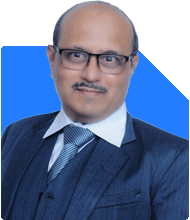Can I Get A Pension from My Previous Pvt Employer's EPS 1995 contributions as a 68 year old, if I have no UAI?
Milind Vadjikar | Answer |Ask -Follow
Insurance, Stocks, MF, PF Expert - Answered on Oct 15, 2024
He has a mechanical engineering degree from Government Engineering College, Sambhajinagar, and an MBA in international business from the Symbiosis Institute of Business Management, Pune.
With over 16 years of experience in stock investments, and over six year experience in investment guidance and support, he believes that balanced asset allocation and goal-focused disciplined investing is the key to achieving investor goals.... more

I have worked in pvt institution from Oct 1981 to Nov 2001.My employer had sent my contribution towards EPS 1995 scheme from August 1982 (confirmation) to November 2001(resignation) to the EPF office.A cirtificate of my contribution till 1998 is issued to me by my employer.I want to know whether I am eligible for pension or not as at present I am 68 yrs. If not how can I withdraw the amount contributed by me. I have no UAI no. I have only the A/C no. as issued by my employer. Moreover,can I activate (KYC) my EPFS account now if possible.
You may seek help of a lawyer specializing in labour & EPF laws.
You may approach the EPFO assigned to your employer during that time through your lawyer and ascertain whether EPS pension payment is possible for you.
Best wishes!!
You may like to see similar questions and answers below
Ramalingam Kalirajan |10906 Answers |Ask -Follow
Mutual Funds, Financial Planning Expert - Answered on Apr 23, 2024
T S Khurana |538 Answers |Ask -Follow
Tax Expert - Answered on Sep 24, 2024
Milind Vadjikar | Answer |Ask -Follow
Insurance, Stocks, MF, PF Expert - Answered on Nov 28, 2024
Nitin Narkhede |113 Answers |Ask -Follow
MF, PF Expert - Answered on Jan 16, 2025
Nitin Narkhede |113 Answers |Ask -Follow
MF, PF Expert - Answered on Jan 16, 2025
Ramalingam Kalirajan |10906 Answers |Ask -Follow
Mutual Funds, Financial Planning Expert - Answered on Dec 19, 2025
Nayagam P P |10859 Answers |Ask -Follow
Career Counsellor - Answered on Dec 19, 2025
Ramalingam Kalirajan |10906 Answers |Ask -Follow
Mutual Funds, Financial Planning Expert - Answered on Dec 19, 2025
Ramalingam Kalirajan |10906 Answers |Ask -Follow
Mutual Funds, Financial Planning Expert - Answered on Dec 19, 2025
Ramalingam Kalirajan |10906 Answers |Ask -Follow
Mutual Funds, Financial Planning Expert - Answered on Dec 19, 2025
Radheshyam Zanwar |6751 Answers |Ask -Follow
MHT-CET, IIT-JEE, NEET-UG Expert - Answered on Dec 19, 2025
Radheshyam Zanwar |6751 Answers |Ask -Follow
MHT-CET, IIT-JEE, NEET-UG Expert - Answered on Dec 19, 2025
Samraat Jadhav |2514 Answers |Ask -Follow
Stock Market Expert - Answered on Dec 18, 2025
Reetika Sharma |432 Answers |Ask -Follow
Financial Planner, MF and Insurance Expert - Answered on Dec 18, 2025
Reetika Sharma |432 Answers |Ask -Follow
Financial Planner, MF and Insurance Expert - Answered on Dec 18, 2025


























